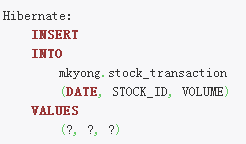What is dynamic-insert
The dynamic-insert attribute tells Hibernate whether to include null properties in the SQL INSERT statement. Let explore some examples to understand more clear about it.
Dynamic-insert example
1. dynamic-insert=false
The default value of dynamic-insert is false, which means include null properties in the Hibernate’s SQL INSERT statement.
For example, try set some null values to an object properties and save it.
StockTransaction stockTran = new StockTransaction();
//stockTran.setPriceOpen(new Float("1.2"));
//stockTran.setPriceClose(new Float("1.1"));
//stockTran.setPriceChange(new Float("10.0"));
stockTran.setVolume(2000000L);
stockTran.setDate(new Date());
stockTran.setStock(stock);
session.save(stockTran);Turn on the Hibernate “show_sql” to true, you will see the following insert SQL statement.

Hibernate will generate the unnecessary columns (PRICE_CHANGE, PRICE_CLOSE, PRICE_OPEN) for the insertion.
2. dynamic-insert=true
If set the dynamic-insert to true, which means exclude null property values in the Hibernate’s SQL INSERT statement.
For example, try set some null values to an object properties and save it again.
StockTransaction stockTran = new StockTransaction();
//stockTran.setPriceOpen(new Float("1.2"));
//stockTran.setPriceClose(new Float("1.1"));
//stockTran.setPriceChange(new Float("10.0"));
stockTran.setVolume(2000000L);
stockTran.setDate(new Date());
stockTran.setStock(stock);
session.save(stockTran);Turn on the Hibernate “show_sql” to true. You will see the different insert SQL statement.

Hibernate will generate only the necessary columns (DATE, STOCK_ID, VOLUME) for the insertion.
Performance issue
In certain situations, such as a very large table with hundreds of columns (legacy design), or a table contains extremely large data volume, insert something not necessary definitely will drop down your system performance.
How to configure it
You can configure the dynamic-insert properties value through annotation or XML mapping file.
1. Annotation
@Entity
@Table(name = "stock_transaction", catalog = "mkyong")
@org.hibernate.annotations.Entity(dynamicInsert = true)
public class StockTransaction implements java.io.Serializable {2. XML mapping
<class ... table="stock_transaction" catalog="mkyong" dynamic-insert="true">
<id name="tranId" type="java.lang.Integer">
<column name="TRAN_ID" />
<generator class="identity" />
</id>Conclusion
This little “dynamic-insert” tweak may increase your system performance, and highly recommends to do it. However, one question in my mind is why Hibernate set it to false by default?




 本文探讨了Hibernate中动态插入属性的功能,该功能允许在插入记录时排除空值字段,从而提高系统性能。通过对比默认设置与开启动态插入的区别,并提供配置方法。
本文探讨了Hibernate中动态插入属性的功能,该功能允许在插入记录时排除空值字段,从而提高系统性能。通过对比默认设置与开启动态插入的区别,并提供配置方法。

















 7万+
7万+

 被折叠的 条评论
为什么被折叠?
被折叠的 条评论
为什么被折叠?








